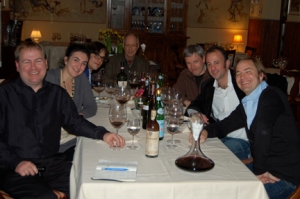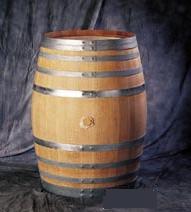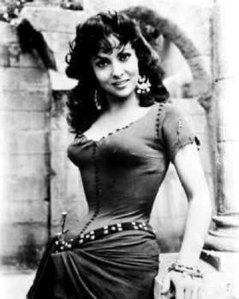As I sit this morning in the splendid Piazzo Zoia in Asti, the snow falls like tears from a cloud. There has been six or seven inches overnight here; in Alba there is over a foot, I am told.
Last night my fellow bloggers and I tasted 30 or so examples of Barbera d’Asti from the subzone of Nizza. We were invited to ask questions of the winemakers. The issue of oak was raised and the temperature in the room became colder than outside. It was a question that needed to be asked: Why is Barbera d’Asti, from Nizza or elsewhere, so often rendered undrinkable by over-enthusiastic use of oak? The answers were prickly and often disingenuous.
It breaks my heart to see what is, or can be, one of Italy’s most spirited and enjoyable red wines turned into the pariah of US wine bloggers. I have fond memories of Aldo Vajra’s Barbera d’Alba Bricco delle Viole, which I expect to taste tomorrow with other Alba examples. In principle these should be the best Barbera from Piemonte, planted on its most privileged terroir.
Surely they cannot be any worse than the wines that we have tasted since Monday. Admittedly I am guilty of gluttony and lust over the last couple of days but the violent storms and icy rain (it’s snowing here…) inflicted upon the sinners in the second and third circles of Dante’s Inferno would be less painful than the banshee-like acidity, the senile fruit and the oak – oh the oak! – of the wines here. My lips are more chapped than a polar explorer’s.
So diverse were the colours, aromas and textures of these wines that it stretched credence to credit them all as Barbera d’Asti. Britain has few laws but on the whole they are obeyed. Italy has so many laws that they are totally ignored. It has been near impossible thus far to find a Platonic ideal – a Francesca, if you will – of Barbera.
Below are my notes from Monday’s tasting at Palazzo Zoia. It is irrelevant to cite specific names and producers here because the overall standard was so uniformly disappointing that it is better for the notes to serve as a general overview.
1 Viscous ruby purple, as bright as this Asti morning. Some minerality on the nose. Young, recently bottled? Crisp acidity but refreshing rather than bracing. Fruity tannins. Fun. Now to 2013.
2 Colour as before. Recently bottled? A bit stinky on the nose. Lush fruit. Very moreish. A good example, the fruit showing lots of Barbera tipicità.
3 Lighter colour. Fist bottle corked. Second bottle cleaner but still unpleasant. Dry finish, austere. Charmless. About as pleasant as listening to Tuvan Throat Singing…
4 Ruby purple. Juicy, verging on tartness. As with 2 this is giovanissimo… Try with food!
5 Ruby purple. Dark fruit flavours, lots of tipicità. Some dry tannins on the finish but the flavours are appealing.
6 Purple turning to orange at the rim. Yeoman-like structure and texture but no worse for it…
7 Lighter colour. Confected and vulgar on nose and palate. Yuk.
8 Back to the colour of 6. The first barricato wine of the day! A travesty of what Barbera can be and, secondo me, should be… Oak and Barbera is a combination as unlikely as oil and water.
9 Ominous orange/garnet colour… Thoroughly Maderised. A wine that is tired – terminally. Anybody who buys this wine , or indeed makes it, needs a lobotomy – preferably frontal. Barberic.
10 This is much better, but almost anything would shine after the previous wine… Some oak here but it supports rather than overwhelms the fruit. Non c’e male…
11 Orange/garnet but mercifully much fresher and more spirited than 9. Crisp acidity and some rustic tannins on the finish. A good example of Barbera in the yeoman style.
12 Back to pyrope. Recently bottled? Similar to the first wine.
13 Lighter colour. Not very fresh, with the palate particularly unappetising…
14 Similar colour to before. Awful… Bovril on the nose and vulgar oak-derived flavours on the palate.
15 Lighter colour. Even more confected than 7… yuk.
16 Light colour. Unripe and charmless.
17 Orange colour. Little vigour or freshness here, with a very unappealing finish.
19 Orange. A most peculiar nose, recalling the leafiness of Chilean Carmenère more than the dark fruits of Barbera! Appealing in its own way but not at all typical.
20 Colour as before. Another decrepit wine that completely lacks freshness or verve. Awful.
21 A bit more purple. Ah, this is much more like it! Nice fruit but ever so slightly compromised by over-enthusiastic use of oak that mars the lovely flavours and leaves dry tannins on the finish.
22 Burnt rubber on the nose. Absolutely ghastly.
23 A paucity of freshness, like too many wines before…
24 Pyrope, the deepest and most viscous colour yet. Its appearance suggests an attempt at extraction… This is confected and vulgar, wearing far too much makeup.
25 Lighter colour, turning to orange at the rim. Again confected and sickly sweet. Che peccato…
26 Deeper colour than 25 though not as impenetrable as 24. Intolerably ugly flavours derived from heavy-handed use of oak. Awful.
27 Purple turning to garnet. Sweet and juicy mid-palate but scarred by its lack of freshness. The nose hints at oxidation.
28 Orange garnet. A touch of Bovril on the nose… Manca la freshezza.
29 Colour as per 24. This has been to the same beauty salon as 26 and 14… Unsubtle oak overwhelms the fruit. Yuk.
31 Viscous purple. First bottle corked. Second bottle fleshy and brightly flavoured. A good example of il dolce stil novo that shows how oak and Barbera can work together in harmony.
32 Purple orange. Finally something drinkable! Quite tannic for a Barbera but this is offset by the characteristic acidity. Not bad.
33 Viscous purple. Similar nose to 28, hinting at Bovril… Dry, austere tannins on the finish. Unappealing.
34 A bit lighter than before. The nose is not quite as appealing as the palate, which is relatively low in acidity for a Barbera but has those lovely dark flavours.
35 Orange colour. Far less polished than the previous wine but an honest example of Barbera – which is to say that it has lots of acidity and slightly perturbing aromas…
36 Purple turning to orange. Not a great wine but one of the best example yet in this tasting – plentiful acidity, dark cherry flavours, some tannin. Italianissimo and probably great with food. Yum.
37 Lighter colour. Similar styling to 36 but with less stuffing. Tasty finish. Yum.
38 Orange. Like 28 this lacks freshness.
39 Pyrope, as dark as Alba’s night. It is interesting to taste this after 38, which I suppose would be an “old-fashioned” or “classic” style of Barbera. As its neon colour suggests this is very much in the dolce stil novo. Sweet, juicy fruit but compromised by the oak. Nonetheless there have been worse wines than this here today and it is a good example of the modern school.
40 Lighter colour than before! This seems rather half-hearted… It has some modern stylings, notably the depth of colour and dry tannins, but its texture is quite rustic. I think it should have the benefit of the doubt!
41 Viscous purple/orange. Very charming and sexy (e italiana!) but too polished for me… It doesn’t really taste of Barbera.
42 Colour as before. Ghastly nose of oak-derived flavours. Moreish palate structure – crisp and bright – but not a bit like Barbera.
43 Turning to orange. Nice, quite sexy texture but lacks freshness.
44 Purple turning to orange. Sweet and juicy, with a supple finish. Very appealing and moreish but it ain’t Barbera!
45 Deeply coloured. Very crisp, chewily tannic and surprisingly appealing!
46 Orange/garnet. Verging on one of this wines that lacks freshness… Drink up. Palate better than nose.
47 A bit more purple. Similar to 46 – unappealing nose but the palate has a pleasingly rustic tinge.
49 Viscous purple. C’e troppo legno… The wood scars the fruit like a mole on the face of a pretty ragazza.
50 A bit lighter. Dreadful. Badly reduced? What on earth went wrong here?
52 Purple. Sexy and lush palate but it tastes only of oak. No.
53 Ditto! Less oak influence but still untypical, if rather moreish…
54 And again… Why not label it “red wine for those that don’t care about where it comes from?” To put Barbera d’Asti on the label is a travesty.
55 This is more like it. Dark cherries on the nose. Moreish but retaining a rustic edge. Not bad.
55b Inky purple. The oak shows more on the palate than nose. Bitter, charmless finish. Not one for me.
56 Purple/orange. Shoe polish flavours. Yuk.
57 Like 40 this is neither fish nor fowl…
58 Oak, especially on the finish. No.
59 Purple turning to garnet. This is in the rustic style that for me epitomises Barbera from Piemonte. It recalls wine 36.
60 Viscous purple/orange. Sweet new style, with aromas of oak. No.
60b Colour as before. Like 40 this is a rather lame attempt at making a sexy Barbera. It doesn’t work.
62 A bit more purple. Sexy, lush palate paired with oak aromas. Not for me.
63 Lighter colour. This is good, with a bright finish. Mi piace.
64 Confected and vulgar, with an overly-sweet mid-palate.
65 Ditto, but without the sweetness. Quite tart.
66 Purple/orange. Back to my platonic ideal, à la 55! Morello fruit and a rustic texture. What Barbera d’Asti is all about!
66b Purple/orange. Unappealing nose scarred by VA. Short.
67 More purple. Oak on the nose. Palate quite lush but not characteristic.
68 Purple. The nose has some character but the palate is very dry and charmless. No.
68b Colour as before. Oak on the nose – yuk. Ditto on the finish.
 The exhibition ties in with the recent publication of Vincent Van Gogh – The Letters: The Complete Illustrated and Annotated Edition, a magnificent six-volume edition of 902 letters to and from Vincent.
The exhibition ties in with the recent publication of Vincent Van Gogh – The Letters: The Complete Illustrated and Annotated Edition, a magnificent six-volume edition of 902 letters to and from Vincent.






